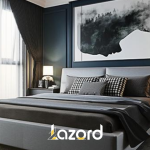At first, you will think that the word interior design means complementing the home decor with some basic features.
In fact, interior design goes even further. A house without interior design means a house in one color, devoid of details, colors and accessories.
Any interior design specialty includes studying the place and creating an integrated plan for it, and includes studying the desired purpose of the place before creating an interior design for it. Then, the appropriate colors for the walls, ceiling, and floors are chosen, and the preferred and appropriate furniture and accessories for the place are suggested.
This comprehensive guide provides us with comprehensive information about what is meant by the term interior design. Read on to find out more.
What do we mean when we say interior design?
By interior design, we mean the planning and design of interior spaces within spaces. This process aims to improve these spaces to suit the needs of individuals, and ensure a higher level of security and safety of the buildings.
When we say interior design, we are talking about technical and planning aspects, which are also concerned with the aesthetic and artistic aspects of the place.

You can read more about: https://lazorddecor.com/how-to-decorate-your-home/
What is interior architecture?
Interior architecture or decoration is a form of design, and it works to transform a space into an attractive, functional and easy-to-use room for individuals.
Decorative elements include wall paint, wallpaper, other flooring, ceilings, carpentry, lighting, selection of furniture, and fixtures.
Spaces can also be customized through interior architecture by adding paintings and sculptures through design that suits the nature of the place.
Principles of Interior Design
Balance, Harmony, and Contrast The key to any successful design lies in balance. Achieving harmony involves combining elements like color, texture, and shape in a way that feels pleasing to the eye. Contrast, on the other hand, adds interest by juxtaposing opposites, like light and dark or smooth and rough.
Scale and Proportion Choosing furniture and decor that complements the size of a room is crucial. Scale refers to how an object’s size relates to the space, while proportion concerns the size relationships between various elements.
Rhythm and Repetition Repetition of design elements, such as patterns or color schemes, helps create a sense of continuity and flow within a room. It can also guide the eye across different spaces, enhancing the overall coherence of the design.
Cinematic decoration
Cinematic decor differed in nature from the art of interior decoration and architecture. When we say cinematic interior designing, we do not necessarily mean designing the place to look more beautiful, but rather to perform a specific function.
For example, a cinematic design for a house can be made to look rustic and poor, or the interior decoration of a room can be made to be a bedroom when it is not.
When working on a cinematic interior decoration, the interior designer invests his tools in proportion to the written content.
Designing Different Rooms in a House
Living Room The living room is often the centerpiece of a home. When designing this space, consider both comfort and style. A mix of seating options, a focal point like a fireplace, and proper lighting are key elements.
Kitchen A functional kitchen layout should prioritize the “kitchen triangle” (the relationship between the stove, sink, and refrigerator). Incorporate plenty of storage and counter space for maximum efficiency.
Bedroom For a serene and restful bedroom, opt for soft, calming colors and cozy textiles. The placement of the bed is crucial, often best placed against the longest wall with ample space for movement.
Bathroom A well-designed bathroom combines practicality with luxury. Use tiles, lighting, and mirrors strategically to create an illusion of space in smaller bathrooms.
Home Office With more people working from home, the design of home offices has become essential. Focus on ergonomics, lighting, and personalized touches to enhance productivity and comfort.
The importance of color in interior design
Color is an essential interior design element due to its impact on individuals’ sensory and visual perception. Color also integrates with other interior design elements, and three basic characteristics of color are identified:
- Color characteristic.
- Color value.
- Color intensity.
The use of color within design varies according to the nature of the place, its function, the preferences of the homeowner, and also the style of design that the designer is working on.
Various interior designing specializations
Interior design, by its practical nature, belongs to the plastic arts. Each specific type of interior designing aims to achieve a specific function.
The different interior decoration specializations can be differentiated through the following division:
- Architectural design.
- Decorative art.
- Furniture design.
Interior decoration is essential because it gives the final look to the place, determines our relationship with it and the level of comfort and security we feel as well. Interior designing is an essential element in any home, company or office.
It is determines the final appearance of the place






